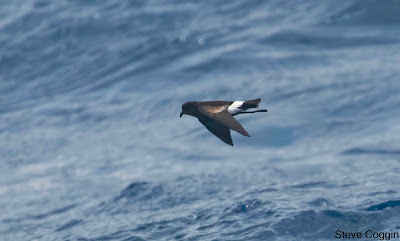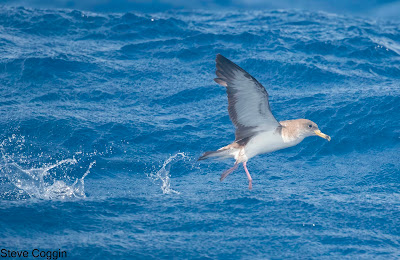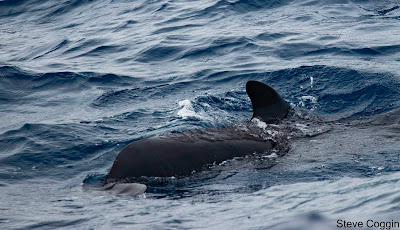 |
| Northern Gannet (Morus bassanus). Dare County, North Carolina |
Birders favor strange places; like swamps in northern Minnesota (in winter), the deserts of southern Arizona (in summer) or tiny islands in the Bering Sea (not in winter). Then there is a word, a word that brings a gleam to birder's eyes, pelagic. This ancient word comes from Greek and means the sea. Marine scientists refer to the pelagic zone as the open ocean where marine organisms can move freely and not encounter land. Pelagic sea life includes creatures ranging in size from herring to whales. Tunas, sharks and marlins are all pelagic fish. But to birders pelagic has a different meaning. Pelagic means a trip on the open ocean looking for birds that only come on land to breed.
 |
| Oregon Inlet sunrise. Dare County, North Carolina. |
 |
| Sunrise from the deck of the Stormy Petrel II. Dare County, North Carolina. |
Winter
 |
| Sooty Shearwater (Ardenna grisea). Dare County, North Carolina. |
Winter pelagic trips off the North Carolina coast can yield an amazing variety of birds. Inshore, the water is cold but farther out the warm Gulfstream raises the water temperature and brings other creatures into view. Sooty Shearwaters (Ardenna grisea) breed in the South Atlantic and Pacific then wander counterclockwise around these oceans. They are sooty gray-brown in color with long straight wings. Sooty Shearwaters glide low over the surface of the ocean where they snatch up squid and small fish. One winter day we saw a lingering Sooty Shearwater from the deck of the Stormy Petrel II.
 |
| Razorbill (Alca torda). Dare County, North Carolina. |
 |
| Razorbills. Dare County, North Carolina. |
 |
| Manx Shearwater (Puffinus puffinus). Dare County, North Carolina. |
Manx Shearwaters (Puffinus puffinus) traditionally bred on islands along the north coast of Europe. But in the late 20th century they established nesting colonies in eastern Canada and New England. Manx Shearwaters are becoming increasing common on North Carolina pelagic trips.
 |
| Two Red Phalaropes (Phalaropus fulicarius) on the left and and a Red-necked Phalarope (Phalaropus lobatus) on the right. Dare County, North Carolina. |
Phalaropes are odd shorebirds. They don’t just wade, they float on the water using their legs to spin in circles. On a winter pelagic we saw flocks of Red Phalaropes (Phalaropus fulicarius) miles out in the Atlantic. These small birds nest on the Arctic tundra but spend their winters on the open ocean. Their breeding plumage is impressive with a red breast, white mask and black cap. In winter these birds sport a much more subdued plumage of black and white and they are perfectly at home riding the waves. Among the Red Phalaropes there was a single Red-necked Phalarope (Phaloropus lobatus) that usually spends the winter farther south.
 |
| Northern Gannet. Dare County, North Carolina. |
The most impressive winter birds are the Northern Gannets. We saw flocks of these large black and white sea birds plunging into the water to catch fish. Northern Gannets are native to the North Atlantic and nest on cliffs along the coast of Northern Europe and Canada. They winter as far south as the Caribbean, West Africa and the Mediterranean Sea.
 |
| Hammerhead Shark (Sphyrna sp). Dare County, North Carolina. |
There were interesting creatures down in the water too. Several large Hammerhead Sharks (Sphyrna sp.) were feeding close to the surface. They were sandy brown in color and about 9 feet long. We also got to see a truly bizarre fish, the Ocean Sunfish (Mola mola). They are among the largest boney fish and can reach 10 feet in length. Ocean Sunfish are laterally flattened, like a flounder, and bask at the surface giving them their name. They have a large dorsal and ventral fins that can extend above the surface and may be mistaken for a shark. Ocean Sunfish have a greatly reduced tail and look like giant swimming fish heads.
 |
| Ocean Sunfish (Mola mola). Dare County, North Carolina. |
Spring
 |
| Sargassum sp. in the Gulf Stream. Dare County, North Carolina. |
A trip in May on the Stormy Petrel II gives a
completely different view of the ocean and its inhabitants. These voyages go into the Gulf Stream and its
warm, blue waters brings different species. The
brown seaweed Sargassum sp. is found floating in the Gulf Stream and
provides shelter for many fish. Atlantic
Bottlenose Dolphins (Tursiops truncatus) dash through the water and can
often be seen riding the bow wake of boats.
These familiar marine mammals are gray, with a strongly hooked
dorsal fin and reach 10 feet in length.
They feed on fish, squid and other marine life.
 |
| Atlantic Bottlenose Dolphins (Tursiops truncatus). Dare County, North Carolina. |
Gervais’s Beaked Whales (Mesoplodon europaeus) are toothed whales found in tropical and temperate waters of the Atlantic. They are larger than the Atlantic Bottlenose Dolphins and have a similar diet. On a pelagic trip in May we were lucky enough to find one of the unusual whales.
 |
| Gervais's Beaked Whale (Mesoplodon europaeus). Dare County, North Carolina. |
Several species of Strom Petrels are found in the Gulf Stream off North Carolina and lend their name to the boat that takes us on these pelagic trips. Wilson’s Storm Petrels (Oceanites oceanicus) are the most common. They are delicate looking black and white sea birds that patter their feet across the water’s surface as they feed. They breed on the margins of the Antarctic continent and on southern islands. Wilson’s Storm Petrels disperse through the world’s oceans for the rest of the year and are common off the coast of North Carolina during our warm months.
 |
| Wilson's Storm Petrel (Oceanites oceanicus). Dare County, North Carolina. |
Pomarine Jaegers (Stercorarius pomarinus) are impressive birds that catch fish at the surface or harass other birds to steal their hard caught meals. They breed on the Arctic tundra of North America, Europe and Asia then disperse south in all the oceans. Pomarine Jaegers have a wingspan of over 4 feet, a hooked beak, black head and collar and long central tail feathers.
 |
| Pomarine Jaeger (Stercorarius pomarinus). Dare County, North Carolina. |
Summer
 |
| Wilson's Storm Petrel. Dare County, North Carolina. |
 |
| Great Shearwater (Ardenna gravis). Dare County, North Carolina. |
 |
| Great Shearwater. Dare County, North Carolina. |
Great Shearwaters breed on just a few islands in the South Atlantic then migrate as far north as Greenland. These large seabirds soar effortlessly over the surface of the water snapping up fish and squid as they do. Great Shearwaters are dark above, white below with a gray cap.
 |
| Cory's Shearwater (Calonectris borealis). Dare County, North Carolina. |
Cory’s Shearwaters are dark on the top of the wings, back and tail. Beneath they have a white breast and belly, and white wings edged in black. Scopoli’s Shearwaters have recently been split off from Cory’s and look very similar.
 |
| Scopoli's Shearwater (Calonectris diomedea), Dare County, North Carolina. |
One of the most impressive seabirds on this summer trip to the Gulf Stream was the White-tailed Tropicbird (Phaethon lepturus). This beautiful bird is found in tropical oceans around the world and nests on islands including Bermuda. White-tailed Tropicbirds are pure white except for a black eye line and black markings on the wings. They have yellow beaks and a long, white streamer tails. A pair of White-tailed Tropicbirds followed the boat for 5 minutes, stunning all aboard with their elegance.
 |
| White-tailed Tropicbird (Phaethon lepturus). Dare County, North Carolina. |
 |
| White-tailed Tropicbird. Dare County, North Carolina. |
A small pod of Short-finned Pilot Whales (Globicephala macrorhynchus) also put in appearance. These black whales are about 16 feet long and live in matrilineal social groups. They are found in temperate and tropical regions of all the oceans and are often involved in mass strandings.
 |
| Short-finned Pilot Whale (Globicephala macrorhynchus). Dare County, North Carolina. |
 |
| Short-finned Pilot Whale. Dare County, North Carolina. |
Going on a pelagic is always an adventure. It can be rough, windy, cold or rainy and sometimes all four. On other days the sea can be like a millpond with dazzling sunlight. These elements; the sea, the sky and the birds make for a memorable day.
 |
| Sunrise over the Atlantic on a pelagic birding trip. Dare County, North Carolina. |
No comments:
Post a Comment